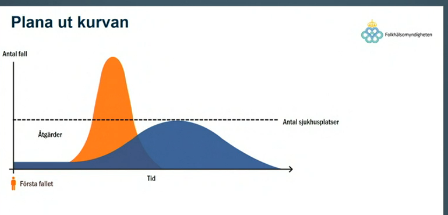
No data reported from @Folkhalsomynd today, but the situation in ICU is looking grim. @janlotvall was curious yesterday exactly how grim, so I've looked more closely.
Sweden normally has 523 ICU beds.
portal.icuregswe.org/seiva/en/rappo…
Sweden normally has 523 ICU beds.
portal.icuregswe.org/seiva/en/rappo…
At the end of week 42, approximately 386 of those beds were available. There were 24 Covid patients.
portal.icuregswe.org/seiva/en/terti…
portal.icuregswe.org/seiva/en/terti…
As of this morning, just after the end of week 45, there were 120 covid patients, an increase of nearly 100 since week 42 and a doubling since the end of October, 8 days. The previous doubling time was about 10 days. 

That leaves Sweden with less than 290 available ICU beds. If Covid ICU doubling time remains at ~10 days or less, our ICU capacity will be full in less than 2 weeks.
Of course, this is Sweden as a whole, and the virus is more widespread now than it was in Spring.
Of course, this is Sweden as a whole, and the virus is more widespread now than it was in Spring.
No surprise therefore, that we're already seeing overall *more* pressure than in the Spring, with a greater number of patients having to be transferred because of a lack of capacity, with smaller hospitals struggling. 

Despite triaging away elderly patients, with over 80s essentially stopped being admitted from April, and few over 70, Sweden (just) exceeded it's total normal ICU capacity.
Despite this, authorities claimed health services had been protected and admissions had "plateaued"
Despite this, authorities claimed health services had been protected and admissions had "plateaued"
Several observers, including myself, concluded that what had actually happened was a ceiling had been reached. Numbers in ICU weren't increasing because no more patients needed it, but because there was no more room.
https://twitter.com/DavidSteadson/status/1268960776687157250?s=20
On average, SIR reports a little over 10 days as the average time between admission to hospital and admission to ICU for Covid patients.
In the past 10 days, hospitalisations for Covid have increased from 474 to at least 977. More than double.
platz.se/coronavirus/#j…
In the past 10 days, hospitalisations for Covid have increased from 474 to at least 977. More than double.
platz.se/coronavirus/#j…
This is consistent with the ICU doubling time and confirms further that we will almost certainly be at normal ICU capacity in less than 2 weeks, and exceeding the numbers of April shortly afterwards.
This is likely going to happen no matter what the effect of the recent new "recommendations". They were implemented too late to stop this, and the Uppsala experience indicates that, at best, exponential growth may have slowed, but has not stopped. 

Anders Tegnell's strategy to allow the virus to spread, but slow it enough to protect health care has failed. This will be clear to see in 2-3 weeks.
/end
/end
• • •
Missing some Tweet in this thread? You can try to
force a refresh







